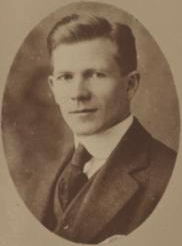Absalom Willis Robertson facts for kids
Quick facts for kids
Absalom Willis Robertson
|
|
|---|---|
 |
|
| United States Senator from Virginia |
|
| In office November 6, 1946 – December 30, 1966 |
|
| Preceded by | Thomas G. Burch |
| Succeeded by | William B. Spong Jr. |
| Member of the U.S. House of Representatives from Virginia's 7th district |
|
| In office March 4, 1933 – November 5, 1946 At-large: March 4, 1933 – January 3, 1935 |
|
| Preceded by | John W. Fishburne |
| Succeeded by | Burr Harrison |
| Member of the Virginia Senate from the 22nd district |
|
| In office January 12, 1916 – January 9, 1924 |
|
| Preceded by | William T. Paxton |
| Succeeded by | Robert J. Noell |
| Personal details | |
| Born | May 27, 1887 Martinsburg, West Virginia, U.S. |
| Died | November 1, 1971 (aged 84) Lexington, Virginia, U.S. |
| Nationality | American |
| Political party | Democratic |
| Spouse | Gladys Churchill Willis |
| Children | 2, including Pat Robertson |
| Relatives | Gordon P. Robertson (grandson) |
| Education | University of Richmond (B.A., 1907) |
Absalom Willis Robertson (born May 27, 1887 – died November 1, 1971) was an American politician from Virginia. He worked in public service for over 50 years. He was a member of the Democratic Party.
Robertson represented Virginia in the U.S. House of Representatives from 1933 to 1946. He then served in the U.S. Senate from 1946 to 1966. Before that, he was part of the Virginia General Assembly, which is Virginia's state legislature. Robertson was also the father of televangelist and political commentator Pat Robertson.
Contents
Early Life and Education
Willis Robertson was born in Martinsburg, West Virginia. His parents were Franklin Pierce Robertson and Josephine Ragland (née Willis). He was born just two weeks before another famous Virginia Senator, Harry F. Byrd, who was born in the same town. Robertson went to the University of Richmond and graduated in 1907.
Starting His Political Career
After college, Robertson became a lawyer. He then started his career in politics. In 1915, he was elected to the Virginia State Senate. He represented areas like Bedford and Rockbridge counties. He served as a state senator from 1916 to 1922. During World War I, Robertson joined the United States Army. However, he stayed in the U.S. so he could continue his part-time job as a state senator.
From 1922 to 1928, Robertson worked as the Commonwealth Attorney for Rockbridge County, Virginia. This job involved being the chief prosecutor for the county.
Serving in the U.S. Congress
In 1932, Robertson was elected to the United States House of Representatives. He represented Virginia's 7th congressional district. He was reelected six times, serving for many years.
In 1946, he won a special election to become a U.S. Senator. He took office the day after the election. He won the full Senate seat in 1948 and was reelected two more times.
One important law he helped create was the Pittman–Robertson Federal Aid in Wildlife Restoration Act. This law uses taxes from hunting equipment and ammunition to help states fund wildlife areas. It's still a main way to pay for protecting wildlife today.
Robertson was the chairman of the U.S. Senate Committee on Banking, Housing, and Urban Affairs from 1959 to 1966. This committee deals with laws about banks, money, and housing.
Views on Civil Rights
During his time in Congress, Robertson was part of a group called the "conservative coalition." He was against the Civil Rights Movement. In 1956, he was one of 19 senators who signed the Southern Manifesto. This document was against the U.S. Supreme Court's decision in Brown v. Board of Education (1954). This court ruling said that schools should not be separated by race.
Robertson believed that separate schools for different races could still be equal. He thought that forcing schools to integrate quickly would cause problems. He also felt it went against people's right to choose their friends.
When President Lyndon B. Johnson's wife, Lady Bird Johnson, traveled through the South to gain support for new civil rights laws, Robertson refused to meet with her.
In 1966, President Johnson supported William B. Spong Jr. to run against Robertson. Spong was a more liberal Democrat. Spong defeated Robertson in the primary election. This was a big surprise in Virginia politics. It showed that the political landscape in Virginia was starting to change.
Death
Absalom Willis Robertson passed away in Lexington, Virginia, in 1971. He was buried in Oak Grove Cemetery. His important papers are kept at the Swem Library at the College of William and Mary.
Electoral History
- In 1934, Robertson was elected to the U.S. House of Representatives.
- He was re-elected to the House several times, including in 1936, 1938, 1940, 1942, and 1944.
- In 1966, he was defeated when he tried to be re-elected to the U.S. Senate.
See Also
- List of United States Congress members from Virginia
Images for kids




